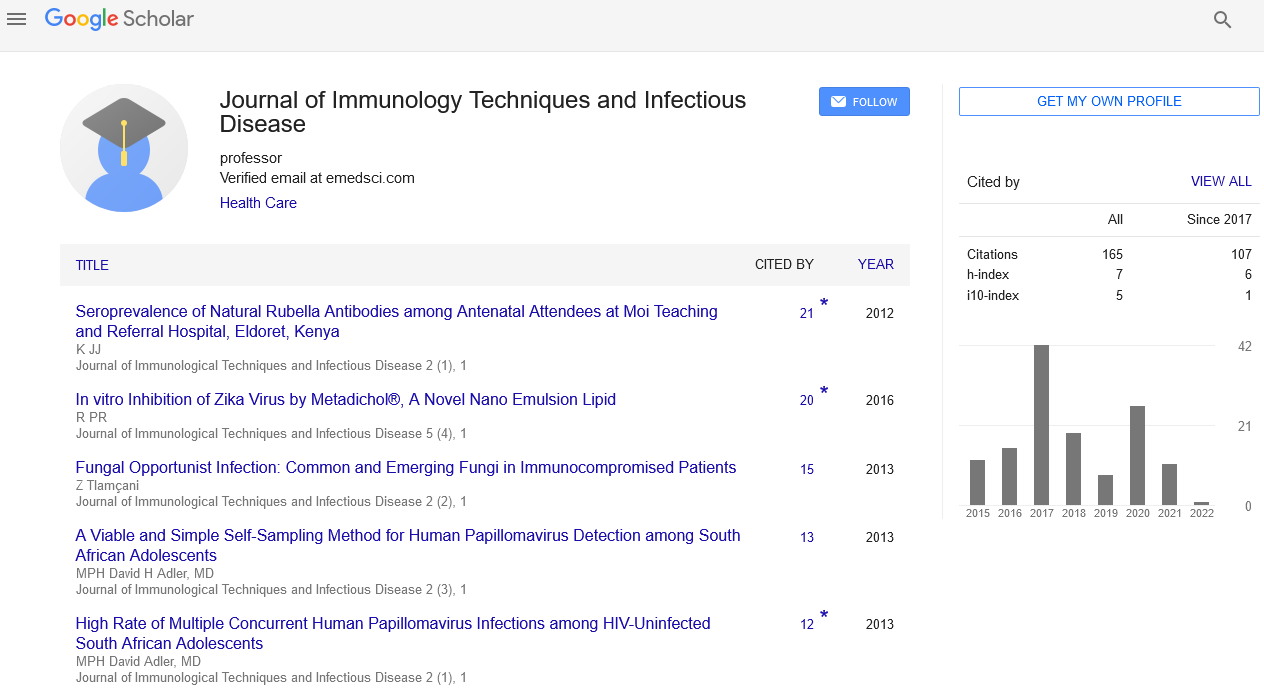Opinion Article, J Immunol Tech Infect Dis Vol: 12 Issue: 3
Intestinal Roundworms: A Comprehensive Overview
Suke Uzawa*
1Department of Stem Cell and Immune Regulation, Yokohama City University, Yokohama, Japan
*Corresponding Author: Suke Uzawa,
Department of Stem Cell and Immune
Regulation, Yokohama City University, Yokohama, Japan
E-mail: sukeuzawa123@gmail.com
Received date: 30 August, 2023, Manuscript No. JIDIT-23-116439;
Editor assigned date: 01 September, 2023, PreQC No. JIDIT-23-116439 (PQ);
Reviewed date: 15 September, 2023, QC No. JIDIT-23-116439;
Revised date: 22 September, 2023, Manuscript No. JIDIT-23-116439 (R);
Published date: 29 September, 2023, DOI: 10.4172/2329-9541.1000352.
Citation: Uzawa S (2023) Intestinal Roundworms: A Comprehensive Overview. J Immunol Tech Infect Dis 12:3.
Description
Intestinal roundworms, also known as nematodes, are a group of parasitic worms that infect the human gastrointestinal tract. These worms are a significant global health concern, particularly in developing countries with poor sanitation and limited access to healthcare. There are several species of intestinal roundworms that can infect humans. Ascaris is one of the largest and most common intestinal roundworms. It can grow up to 35 cm long and is typically found in areas with poor sanitation. Ascaris eggs are ingested, and the larvae migrate through the body before reaching the intestines, where they mature into adult worms. Whipworms are named for their whiplike appearance. They are transmitted through the ingestion of contaminated food or water. These worms attach themselves to the walls of the large intestine and can cause various gastrointestinal symptoms. Pinworms are the most common worm infection in the United States and other developed countries. They are tiny and white and typically infect children. Female pinworms lay their eggs around the anus, causing itching and discomfort. There are several species of hookworms, including Ancylostoma duodenale and Necator americanus. These worms are found in tropical and subtropical regions and enter the body through the skin, often when walking barefoot on contaminated soil. Hookworms attach to the small intestine walls, causing anemia and other health issues. Strongyloides is a soil-transmitted roundworm that can penetrate the skin and migrate through the body before reaching the intestines. Chronic infections can lead to a severe condition known as hyperinfection syndrome, which can be life-threatening.
Life cycle of intestinal roundworms
Understanding the life cycle of intestinal roundworms is important for both prevention and treatment. While the specifics of each worm's life cycle may vary, they share some common stages:
Egg stage: Intestinal roundworms begin their life cycle as eggs. These eggs are typically shed in the feces of an infected person and can survive in the environment for extended periods, depending on environmental conditions.
Larval stage: Once the eggs are ingested or come into contact with the human host, they hatch into larvae. These larvae then migrate through the body, often causing symptoms as they move.
Adult stage: After migrating to the gastrointestinal tract, the larvae mature into adult worms. These worms attach themselves to the intestinal walls and start reproducing, producing more eggs. In the case of pinworms, females may lay eggs around the anus, causing itching.
Symptoms of intestinal roundworm infections
The symptoms of intestinal roundworm infections can vary depending on the type and severity of the infestation. Common symptoms include:
Abdominal pain: Intestinal roundworms can cause abdominal pain and discomfort, often resembling symptoms of gastrointestinal disorders.
Diarrhea: Some roundworm infections can lead to chronic diarrhea, which may result in dehydration and malnutrition.
Weight loss: Prolonged infections can lead to weight loss and malnutrition, particularly in children.
Anemia: Hookworm infections can cause anemia due to blood loss from the intestinal walls where the worms attach.
Itching: Pinworm infections often cause itching around the anus due to the presence of eggs.
Fatigue: Chronic roundworm infections can lead to fatigue and weakness, as the body's resources are depleted.
Diagnosis and treatment
Diagnosing intestinal roundworm infections typically involves a combination of clinical evaluation, symptom assessment, and laboratory tests. A stool sample can be examined for the presence of roundworm eggs or larvae. In the case of pinworms, a piece of transparent tape is applied to the perianal area to collect eggs for microscopic examination. Once diagnosed, treatment usually involves the use of anthelmintic medications, which are specifically designed to kill parasitic worms. Common medications include albendazole, mebendazole, and ivermectin. The choice of medication depends on the type of roundworm and the severity of the infection.
Conclusion
Intestinal roundworm infections remain a significant public health concern, particularly in regions with inadequate sanitation and hygiene facilities. These parasitic worms can cause a range of gastrointestinal symptoms and, in severe cases, lead to malnutrition and anemia. However, with improved sanitation, hygiene practices, and access to effective treatment, the burden of intestinal roundworm infections can be reduced. Public health efforts should continue to focus on prevention, early diagnosis, and treatment to mitigate the impact of these parasitic infections on global health.
 Spanish
Spanish  Chinese
Chinese  Russian
Russian  German
German  French
French  Japanese
Japanese  Portuguese
Portuguese  Hindi
Hindi 
